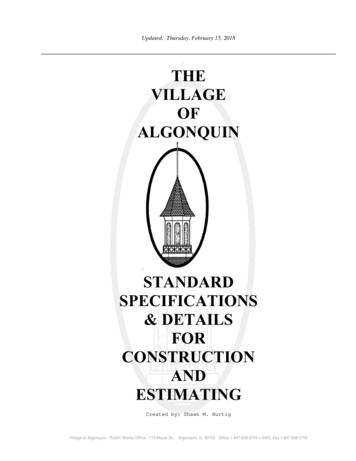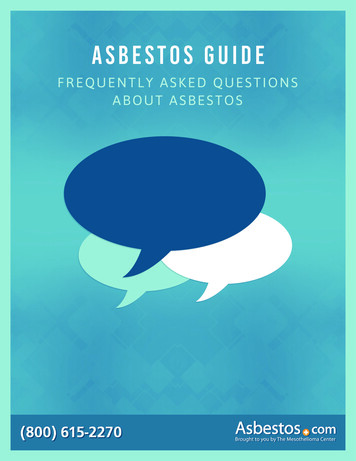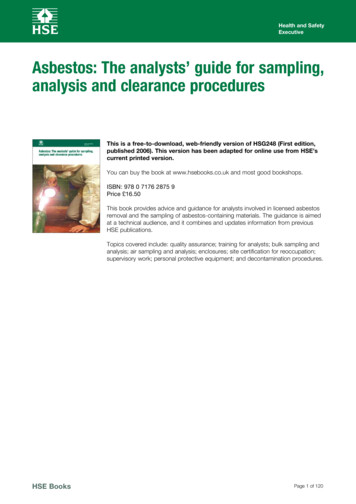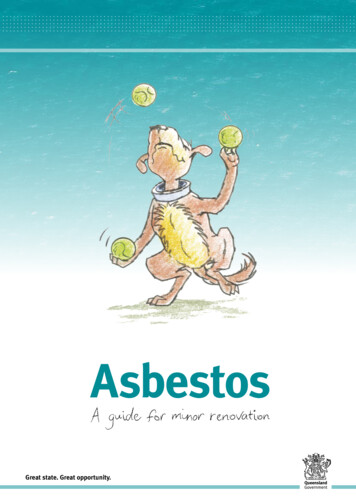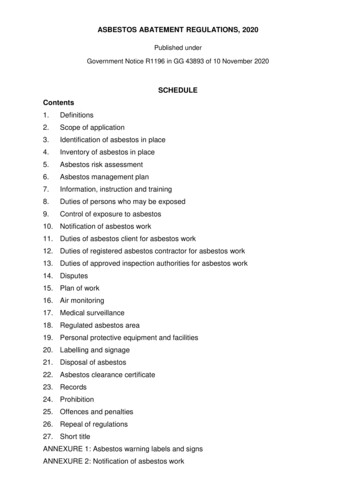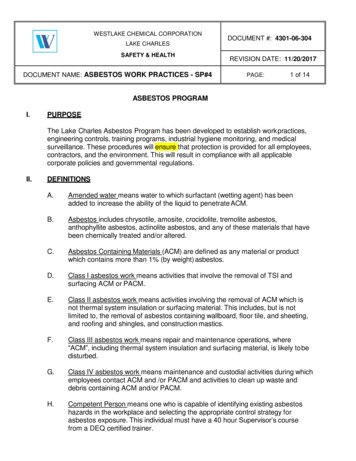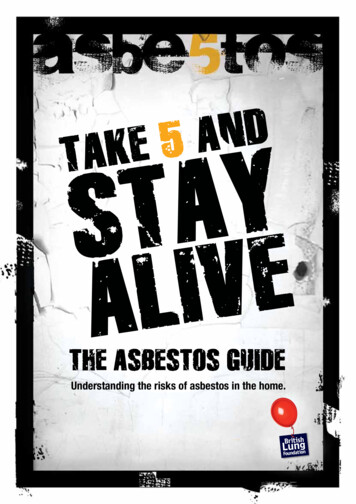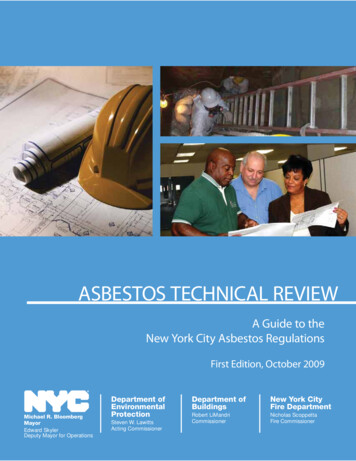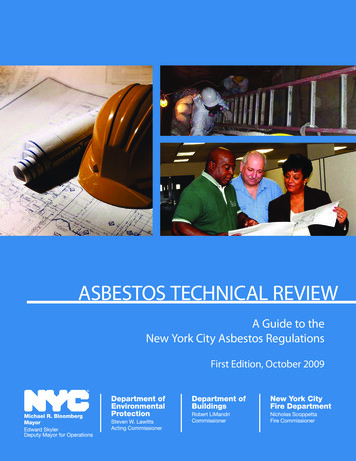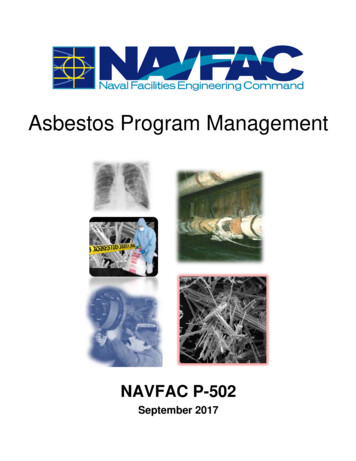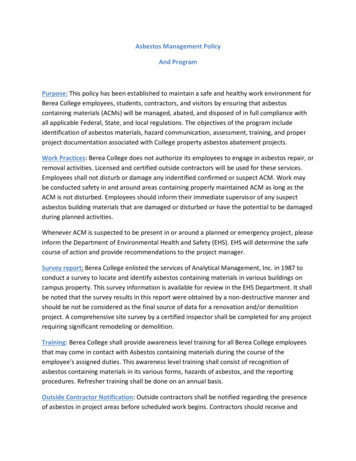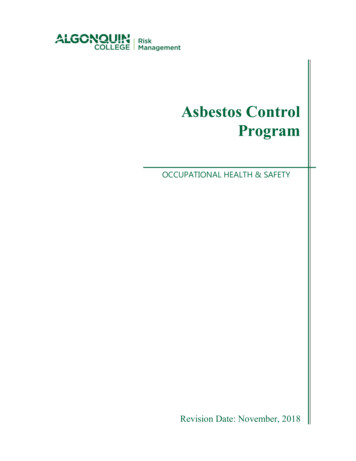
Transcription
Asbestos ControlProgramOCCUPATIONAL HEALTH & SAFETYRevision Date: November, 2018
GLOSSARYACMmeans material that contains 0.5 per cent or more asbestos by dry weight.Acoustical InsulationThe general application or use of asbestos for the control sound due to its lack reverberant surfaces.Acoustical TileA finishing material in a building usually found in the ceiling or walls for the purpose of noise control.AmositeAn Asbestiform mineral of the amphibole group containing approximately 50% Silicon and 40% Iron (II)Oxide, and made up of straight, brittle fibers, light grey to pale brown in colour.AsbestosA generic name given to a number of naturally occurring hydrated mineral silicates that possess aunique crystalline structure, are incombustible in air, and are separable into fibers. Asbestos includedthe asbestiform varieties of chrysotile (serpentine); crocidolite (riebeckite); amosite (cummingtonitegrunerite); anthophyllite; and actinolite.Asbestos ControlMinimizing the generation of airborne asbestos fibers until a permanent solution is developed.AsbestosisA non-malignant, progressive, irreversible lung disease caused by the inhalation of asbestos dust andcharacterized by diffuse fibrosis.CancerA cellular tumour which normally leads to premature death of its host unless controlled.Chrysotile (White Asbestos)The only asbestiform mineral of the serpentine group which contains approximately 40% each of Silicaand Magnesium Oxide. It is the most common form of asbestos used in buildings.Dust MaskSingle use or disposable dust respirator with a low protection factor.FireproofingSpray-or-trowel-applied fire resistant materials applied to building components.Friable AsbestosAny materials that contain more than 1% asbestos by weight and can be crumbled, pulverized orreduced to powder by hand pressure.Half Mask – High EfficiencyA respirator which covers one half of the wearer’s face and is equipped with filters capable ofscreening out 99.7% of all particles larger than 0.3 microns.HEPAHigh Efficiency Particulate Aerosol filterHEPA FilteredA high efficiency particulate air (HEPA) filtered vacuumMesotheliomaA relatively rare form of cancer which develops in the lining of the pleura or peritoneum with no known2
cure.NIOSHThe National Institute for Occupational Safety and Health, which was established by the OccupationalSafety and Health Act of 1970.Non-friableManufactured products containing asbestos.OSHAThe Occupational Safety and Health Administration which was created by the Occupational Safety andHealth Act of 1970; serves as the enforcement agency for safety and health in the workplaceenvironment.PACM (Presumed Asbestos-Containing Materials)Building materials which have been identified by similar building material laboratory analysis ascontaining asbestos or as this material has been known to be manufactured containing asbestos.Phase Contrast Microscopy (PCM)Analytical method used in the determination of airborne fiber concentrations. Note: Does notdifferentiate between asbestos and other fibers.Polarized Light Microscopy (PLM)Analytical method with the use of dispersion staining which can identify asbestos type and content inbulk samples.PolyethylenePlastic sheeting which is often used to seal off an area in which asbestos removal is taking place forthe purpose of preventing contamination of other areas.Pore SizeOn air cassettes the mixed cellulose ester fibers have an average size for dusts, mists or fumes thatmay pass through. For PCM it is larger at 0.8 μm.Supplied AirSupplied air is fresh air either in tanks or pumped through hoses to the worker to provide a breathableair supply in asbestos work environments where the type of asbestos or the airborne asbestosconcentrations make use of other respirators not sufficient to provide proper protection.S.C.B.A.Self Contained Breathing Apparatus is a supplied air system generally used in tanks carried by theworker to provide breathable air. Limitation of the volume of air a worker can carry and the rate atwhich they use the air supply.Transmission Electron Microscopy (TEM)Analytical methods used of the identification of asbestos fibers in air samples and in bulk samples.This method is better for asbestos type and concentration determination. However, the cost issubstantially greater per sample than PCM or PLM analysis.Treated CelluloseAn insulation material made of paper or wood products with fire-retarding treatment added.VermiculiteA micaceous mineral that is sometimes used as a substitute for asbestos which is lightweight andhighly water-absorbent.3
Wet CleaningThe process of eliminating asbestos contamination from surfaces and objects by using cloths, mops, orother cleaning tools which have been dampened with water.Wetting AgentsMaterials that are added to water which is used for wetting the asbestos-containing material in orderfor the water to penetrate more effectively.4
PURPOSEThe purpose of the Algonquin College Asbestos Control Program is the prevention of workerexposure to airborne asbestos and subsequent occupational illness arising from exposure to airborneasbestos. The program outlines the required procedural controls, personal protective equipmentrequirements, specific work procedures and training requirements for College staff and contractors inthe management of asbestos at the College. Asbestos is a designated substance under theOccupational Health & Safety Act of Ontario and the program ensure College compliance with O.Reg837 and O.Reg 278/05.SCOPEThe word "asbestos" is derived from a Greek adjective meaning inextinguishable. The miracle mineralas the Greeks referred it to, was admired for its soft and pliant properties, as well as its strength andits ability to withstand heat. Asbestos is a naturally occurring mineral. From a mineralogical point ofview Asbestos can be divided into two groups: serpentine and amphibole. The important anddistinguishing property of asbestos, compared with non-asbestiform minerals, is the presence of long,thin fibres that can be easily separated. Although, according to some definitions, there are as manyas 30 varieties of asbestos, only six are of commercial importance. These six are listed in theasbestos definition in section 1 of the Ontario Regulation: actinolite, amosite, anthophyllite, chrysotile,crocidolite and tremolite.Serpentine fibres, are flexible and elastic in nature. Chrysotile is the only asbestiform member of theserpentine group of minerals. Although commonly termed "white asbestos", chrysotile fibres may alsobe green, grey, amber or pink in colour. The finely fibrous variety of Chrysotile is the primary sourcefor industrial asbestos because its fibres have high tensile strength, high resistance to alkalis, highflexibility and good spinnability. Chrysotile produces approximately 95 percent of all asbestos worldwide. This is due to the fact that Chrysotile is not affected by fire and is a poor heat conductor.Chrysotile is used for fire retardant devices and heat protection, Its former use, which has beenoutlawed in most areas, was as an insulator, but has been banned because of its notorious nature ofcausing cancer and other long term illnesses. The other 5 percent is amphibole asbestos, such asTremolite and Actinolite).Amphibole asbestos fibres differ from the flexible, curly chrysotile fibres in that they are straight andneedle-like. These fibre characteristics appear to give amphibole asbestos a greater tendency tobecome airborne, which is important to the control of exposure. Two type of amphibole asbestos havebeen widely used: crocidolite or "blue asbestos" and amosite or "brown asbestos". Anthophyllite,tremolite and actinolite asbestos have rarely been used commercially.WHY ASBESTOS WAS USEDAsbestos was widely used in a number of applications due to its ability to withstand high heattemperatures, its strength, its resistance to many corrosive chemicals and its other properties. Asmany as 3,000 separate uses have been identified. The biggest user and consumer of asbestoscontinue to be the construction industry. Due to numerous linked ailments and diseases and workereducation the use of asbestos has dropped dramatically in recent years. However widespread use ofAsbestos has left a potentially dangerous legacy. The thousands of tons of asbestos installed overthe past fifty years can pose a serious risk to workers in the renovation, maintenance, repair anddemolition sectors of the construction industry.The largest single use of asbestos is as a reinforcing agent in cement products. Asbestos-cementproducts include flat and corrugated sheets, pipes and shingles. Another major use is frictionmaterials, including linings for drum and disc brakes and clutch facings. Other asbestos-containingproducts are vinyl asbestos flooring, gaskets and packing, textile products such as welding blanketsand theatre curtains, roofing felts, coatings and mastic, and asbestos paper products.5
One use of asbestos of special note is its use as an insulating material. Asbestos is an effectiveinsulator against heat, cold, electricity and noise. In the late 1960's and early 1970's insulation wasthe largest use of asbestos. Crocidolite was widely used in sprayed insulation and as fireproofing forsteel structures. In some cases the insulation was exposed to provide a decorative architecturalfinish. Elsewhere, it doubled as acoustical insulation. Asbestos pipe and boiler insulation was used onheating systems in buildings, including homes, and in industrial processes.HEALTH HAZARDS ASSOCIATED WITH ASBESTOSSeveral diseases have been linked to the exposure of asbestos, these include but are not limited to:asbestosis, mesothelioma (cancer of the lining of the chest and or abdomen), lung cancer, there isalso evidence of an increased risk of cancer of the stomach, rectum and larynx. These are serious,debilitating diseases that often result in death.To cause disease, asbestos fibres must be inhaled into the lungs. The lung is a system of branchingairways that end in tiny air sacs, called alveoli. There are about 300 million of these tiny air sacs inthe lungs. It is these tiny air sacs that allow oxygen that has been inhaled to enter the bloodstream.This is where fibres below 2.5 microns (approximately one ten-thousandth of an inch) can gainaccess to the lung alveoli. This is where inhaled asbestos fibres do their damage. It is thought that thefibres somehow attach themselves to the alveoli and act as a coated blanket. This in turn affects thediffusion of oxygen into the bloodstream.Fibres with a diameter greater than three microns (one ten-thousandth of an inch) are too large toenter the alveoli and therefore only impact the upper branches of the respiratory system. Fibres thatcan enter the lung and cause disease are too small to be visible to the naked eye.It is not clear how asbestos fibres cause disease after they enter the lung. For each disease there is aperiod of latency, usually more than ten years, between first exposure to asbestos and theappearance of the disease. It is this characteristic that makes asbestos disease so insidious;exposure can continue for many years without any outward evidence of harm while disease developssilently within.Asbestosis: Asbestosis is a disease of the lungs caused by fibrosis (scarring) of the lung tissue,forming around very small asbestos fibers deposited deep into the alveoli of the lungs. As the amountof scar tissue increases, the ability of the lungs to expand and contract decreases, causing shortnessof breath and a heavier workload on the heart. Early detection of asbestosis is possible by X-rayexamination and lung function testing. However, the disease is irreversible and will continue toprogress even after exposure is stopped. Rarely a cause of death itself, asbestosis results in anappreciable reduction in life expectancy due to deaths from related illness.Mesothelioma: Mesothelioma is a rare form of cancer that most often occurs in the thin membranelining of the lungs, chest, abdomen, and (rarely) heart. About 200 cases are diagnosed each year inthe United States. Virtually all cases of mesothelioma are linked with asbestos exposure.Approximately 2 percent of all miners and textile workers who work with asbestos, and 10 percent ofall workers who were involved in the manufacture of asbestos-containing gas masks, contractmesothelioma.People, who work in asbestos mines, asbestos mills, factories, and shipyards that use asbestos, aswell as people who manufacture and install asbestos insulation, have an increased risk ofmesothelioma. So do people who live with asbestos workers, near asbestos mining areas, nearasbestos product factories or near shipyards where use of asbestos has produced large quantities ofairborne asbestos fibers.Lung Cancer: Lung cancer causes the largest number of deaths related to asbestos exposure. Theincidence of lung cancer in people who are directly involved in the mining, milling, manufacturing anduse of asbestos and its products is much higher than in the general population. The most common6
symptoms of lung cancer are coughing and a change in breathing. Other symptoms include shortnessof breath, persistent chest pains, hoarseness, and anemia.People who have been exposed to asbestos and are also exposed to some other carcinogen -- suchas cigarette smoke -- have a significantly greater risk of developing lung cancer than people whohave only been exposed to asbestos. One study found that asbestos workers who smoke are about90 times more likely to develop lung cancer than people who neither smoke nor have been exposedto asbestos.Other Asbestos-Related Cancers: The relationship between asbestos exposure and asbestosis,mesothelioma and lung cancer has been clearly established and is beyond argument. Several othercancers should be noted. They are: gastrointestinal cancer affecting all sites in the gastrointestinaltract (esophagus, stomach, colon and rectum) and cancer of the larynx.Asbestos-Related Conditions: A number of less serious effects have been associated withasbestos exposure: pleural plaques, asbestos bodies and warts. Pleural plaques are areas ofscarring of the pleural surfaces. In general, they are not associated with any functional abnormalityand are merely an indicator of asbestos exposure. Occasionally, they can become so widespread thatthey restrict lung function. Asbestos bodies, also termed "ferruginous bodies", result when asbestosfibres become coated with a substance containing protein and iron. These asbestos bodies are notharmful, and like pleural plaques, serve as evidence of asbestos exposure. Asbestos warts areharmless skin growths that occur when asbestos fibres penetrate the skin.RESPONSIBILITIESGeneral Asbestos Work ProceduresThe following general procedures apply to all staff and contractors at Algonquin College and are to befollowed in all cases of asbestos related work: Prior to commencing ANY, demolition, alteration,construction, renovation and/or development of College facilities and building systems, the projectmanager, supervisor, worker or contractor will do the following: Coordinate all work through the Physical Resources Dept.Will review the Asbestos Survey and provide to all workers involved.If the survey is not completed for that area, Physical resources will hire outside contractors toperform an asbestos survey of the area where the work is to be done, to establish whetherany material that is likely to be handled, dealt with, disturbed or removed, whether friable ornon-friable, is asbestos-containing material.The cost of the survey will be implemented into the project budget and will be charged backto the department who initiates this work.If the area where the work is to be performed contains Asbestos (refer to ACM definition), theasbestos must be removed by a licensed and properly insured Asbestos Abatement Firm.Only after all the Asbestos has been removed and all air sampling concludes that there is noevidence of asbestos in the work environment, will the remainder of the work be completed.All staff / contractors are required to identify any work that may involve potential asbestosexposure to their supervisor and or College supervisor responsible for the contract work.The project manager for the work shall ensure that a work permit form is completed andforwarded to OHS. The work permit form includes the proposed method of work to beperformed, procedures to follow, details regarding locations, work to be done, quantity, dates,etc. (See work permit for asbestos related work).No work shall proceed until the permit has been reviewed and approved by OHS.Upon approval, the work permit will be returned to the project manager for their records and acopy shall be retained by OHS.Upon commencement of any work, the appropriate checklist for the type of work beingcarried out will be utilized. Following completion of the job the checklist will be completed and7
a copy will be forwarded to OHS. (see attached checklists)The supervisor shall maintain theoriginal completed checklist in their records.Upon commencement of any work, the project manager shall ensure that appropriatenotifications of all occupants of the work area are made, that the area is blocked off and thatappropriate signage is posted.ANY changes or substitutions to the original job, must be approved and documented on thework permit by the supervisor.Information for Workers and ContractorsWhenever a worker is to do work that, involves material that, is asbestos containing material, is beingtreated as if it were asbestos-containing material, or the work is to be carried on in close proximity tomaterial that is asbestos containing material, and/or is being treated as if it were asbestos-containingmaterial. The constructor or employer shall advise the worker and provide him or her with thefollowing information: The location of all material that is or is being treated as asbestos containing material. For each location, whether the material is friable or non-friable. In the case of sprayed-on friable material, for each location,1. if the material is known to be asbestos-containing material, the type of asbestos, ifknown, or2. in any other case, a statement that the material will be treated as though it containeda type of asbestos other than chrysotile.Information to Area OccupantsDue to the nature of the work, all asbestos (Type 1, 2 & 3) abatement MUST be communicated aheadof time to area occupants in conjunction with Physical Resources. The purpose of this communicationis to mitigate staff concerns and answer any relevant questions staff may have. This should bediscussed with OHS department prior to.Types of Asbestos Work & Work ProceduresType I Asbestos WorkThe following are examples of Type I asbestos work procedures:(OHS should be contacted for questions surrounding the classification of asbestos work. Also, workprocedures associated with the next highest type classification will be applied in all cases where thereis any doubt regarding the type of work.) Installing or removing ceiling tiles that are asbestos-containing material, if the tiles cover anarea less than 7.5 square metres and are installed or removed without being broken, cut,drilled, abraded, ground, sanded or vibrated.Installing or removing non-friable asbestos-containing material, other than ceiling tiles, if thematerial is installed or removed without being broken, cut, drilled, abraded, ground, sanded orvibrated.Breaking, cutting, drilling, abrading, grinding, sanding or vibrating non-friable asbestoscontaining material if,8
1. the material is wetted to control the spread of dust or fibres,2. and the work is done only by means of non-powered hand-held tools.Removing less than one square metre of drywall in which joint-filling compounds that areasbestos-containing material have been usedThe Ontario Ministry of Labour (Construction Safety Branch) has defined installing cable above falseceilings where a significant quantity of friable material containing asbestos is likely to be lying as aType II operation. Where there is no friable material containing asbestos lying on the ceiling tile, noasbestos procedures are required.Type I Work Procedures1. Before beginning work, visible dust shall be removed with a damp cloth or a vacuumequipped with a HEPA filter from any surface in the work area, including the thing to beworked on, if the dust on that surface is likely to be disturbed.2. The spread of dust from the work area shall be controlled by measures appropriate to thework to be done including the use of drop sheets of polyethylene or other suitable materialthat is impervious to asbestos.3. In the case of an operation where there is removal of less than one square metre of drywall inwhich joint-filling compounds that are ACM, the material shall be wetted before and kept wetduring the work to control the spread of dust or fibres, unless wetting would create a hazardor cause damage.4. A wetting agent shall be added to water that is to be used to control the spread of dust andfibres.5.Frequently and at regular intervals during the doing of the work and immediately oncompletion of the work,i.dust and waste shall be cleaned up and removed using a vacuum equipped with aHEPA filter, or by damp mopping or wet sweeping, and placed in a container that isimpervious to dust (refer to sentence 5 of Type II & III procedures).ii.drop sheets shall be wetted and placed in a container, (refer to sentence 5 of TypeII & III procedures) as soon as practicable after subparagraph i has been compliedwith.6. Drop sheets shall not be reused.7. After the work is completed, polyethylene sheeting and similar materials used for barriers andenclosures shall not be reused, but shall be wetted and placed in a container as described insentence 5 of Type II & III procedures, as soon as practicable after sentence 5 of this sectionhas been complied with.8. After the work is completed, barriers and portable enclosures that will be reused shall becleaned, by using a vacuum equipped with a HEPA filter or by damp wiping, as soon aspracticable after sentences 5 and 7 have been complied with.9. Barriers and portable enclosures shall not be reused unless they are rigid and can becleaned thoroughly.10. Compressed air shall not be used to clean up and remove dust from any surface.11. Eating, drinking, chewing or smoking shall not be permitted in the work area.12. If a worker requests that the employer provide a respirator to be used by the worker, theemployer shall provide the worker with a NIOSH approved respirator in accordance with theRespirator table (refer to back), and the worker shall wear and use the respirator.9
13. If a worker requests that the employer provide protective clothing to be used by the worker,the employer shall provide the worker with protective clothing as described in sentence 5 ofType II & III procedures. and the worker shall wear the protective clothing.14. A worker who is provided with protective clothing shall, before leaving the work area,i. decontaminate his or her protective clothing by using a vacuum equipped with aHEPA filter, or by damp wiping, before removing the protective clothing,ii. if the protective clothing will not be reused, place it in a container as described insentence 5 of Type II & III procedures.15. Facilities for the washing of hands and face shall be made available to workers and shall beused by every worker when leaving the work area.Compressed air must not be used during asbestos removal operations.Equipment: 6 mil polyethylene drop sheet 6 mil disposal bag identified as “Caution Asbestos” a second 6 mil disposal bag Damp cloth or mop and a HEPA vacuum A sprayer containing water and a wetting agent (Liquid Soap). Bucket of water Scrub padOptional Goggles Disposable gloves Disposable coveralls with hood, elasticized wrists and cuffs ½ - face respirator with HEPA filter cartridgesHow to deal with Asbestos FlooringStripping Operations:When stripping floors becomes necessary, the machine used for stripping the finish should beequipped with the least abrasive pad as possible (black pads are usually the most abrasive and thewhite pads the least abrasive). Consult with your floor tile and floor finish product manufacturer forrecommendations on which pad to use on a particular floor covering. Incorporate the manufacturer'srecommendations into your floor maintenance work procedures.The machine used to remove the wax or finish coat should be run at a low rate of speed (i.e., rangingbetween 175-300 rpm) during the stripping operation. There is a direct correlation between machinespeeds and the release of asbestos fibers from asbestos containing floor coverings. The higher themachine speed the greater the probability of asbestos fiber release.Never perform dry stripping. Always strip floors while wet. Do not operate a floor machine with anabrasive pad on unwaxed or unfinished floor containing-asbestos materials.Consult with floor tile and floor finish product manufacturers concerning specific or unique problem(s)on the maintenance of your floorsAfter Stripping:10
After stripping and before application of a high solids floor finish, the floor should be thoroughlycleaned, while wet, preferably with a Wet-Vac HEPA filtration vacuum system.Finishing of Vinyl Asbestos Floor CoveringsUse of Sealer and Solids Finish:Prior to applying a finish coat to a vinyl asbestos floor covering, apply 2 to 3 coats of sealer. Continueto finish the floor with a high percentage solids finish.It is an industry recommendation to apply several thin coats of a high percentage solid finish to obtaina good sealing of the floor's surface, thereby minimizing the release of asbestos fibers during finishingwork.Spray-Buffing Floors:When spray-buffing floors, always operate the floor machine at the lowest rates of speed possibleand equip the floor machine with the least abrasive pad as possible. A recent EPA study indicatedthat spray-buffing with high-speed floor machines resulted in significantly higher airborne asbestosfiber concentrations than spray-buffing with low speed machines.Burnishing Floors:When dry-burnishing floors, always operate the floor machine at the lowest rate of speed possible toaccomplish the task (i.e., 1200-1750 rpms), and equip the floor machine with the least abrasive padas possible.Cleaning After Stripping & Sealing Floors:After stripping a floor and applying a new coat of sealer and finish, use a wet mop for routine cleaningwhenever possible. When dry mopping, a petroleum-based mop treatment is not recommended foruse.11
Type II Asbestos WorkThe following are examples of Type II asbestos work:(OHS should be contacted for questions surrounding the classification of asbestos work. Also, workprocedures associated with the next highest type classification will be applied in all cases where thereis any doubt regarding the type of work.)1. Prior to abatement Physical Resources staff or project manager will communicate to areaoccupants that asbestos removal will be happening on such date.2. Removing all or part of a false ceiling to obtain access to a work area, if asbestos-containingmaterial is likely to be lying on the surface of the false ceiling.3. The removal or disturbance of one square metre or less of friable asbestos-containingmaterial during the repair, alteration, maintenance or demolition of all or part of machinery orequipment or a building, aircraft, locomotive, railway car, vehicle or ship.4. Enclosing friable asbestos-containing material.5. Applying tape or a sealant or other covering to pipe or boiler insulation that is asbestoscontaining material.6. Installing or removing ceiling tiles that are asbestos-containing material, if the tiles cover anarea of 7.5 square metres or more and are installed or removed without being broken, cut,drilled, abraded, ground, sanded or vibrated.7. Breaking, cutting, drilling, abrading, grinding, sanding or vibrating non-friable asbestoscontaining material if,i.the material is not wetted to control the spread of dust or fibres, andii.the work is done only by means of non-powered hand-held tools.8. Removing one square metre or more of drywall in which joint filling compounds that areasbestos-containing material have been used.9. Breaking, cutting, drilling, abrading, grinding, sanding or vibrating non-friable asbestoscontaining material if the work is done by means of power tools that are attached to dustcollecting devices equipped with HEPA filters.10. Removing insulation that is asbestos-containing material from a pipe, duct or similar structureusing a glove bag. * the removal of one square metre or more of insulation that isasbestos containing material, will be treated as a Type III operation. The MOL shall benotified prior to any removal or disturbance.11. Cleaning or removing filters used in air handling equipment in a building that has sprayedfireproofing that is asbestos-containing material.12. An operation that,i.is not mentioned in any of sentencess 1 to 10,ii.may expose a worker to asbestos, andiii.is not classified as a Type 1 or Type 3 operation.Type II Work & Type III ProceduresALL TYPE II AND TYPE III MUST BE CONTRACTED OUT TO AN EXTERNAL FIRM WHOSPECIALIZES IN ASBESTOS ABATEMENT. NO COLLEGE STAFF ARE TO ENGAGE IN SUCHWORK.The following measures and procedures apply to Type 2 operations and to Type 3 operations:1. The work area shall be identified by clearly visible signs warning of an asbestos dust hazard.12
2. Signs required by sentence 1 shall be posted in sufficient numbers to warn of the hazard andshall state in large clearly visible letters that,i.there is an asbestos dust hazard, andii.access to the work area is restricted to persons wearing protective clothing andequipment3. A wetting agent shall be added to water that is to be used to control the spread of dust andfibres.4. Eating, drinking, chewin
The largest single use of asbestos is as a reinforcing agent in cement products. Asbestos-cement products include flat and corrugated sheets, pipes and shingles. Another major use is friction materials, including linings for drum and disc brakes and clutch facings. Other asbestos-containing
